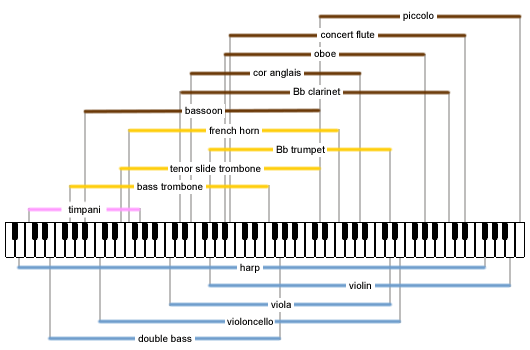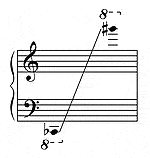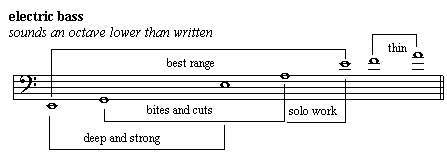
The following is a list of common orchestral instruments grouped by type/family.
Other basic information like instrument range and clef used in scoring are also included for each instrument.
Orchestral Instrument Types
Brass instruments amplify the lip vibrations of the player. Trumpets, trombones and didgeridoos are brass instruments. A didgeridoo is made of wood. It is a brass instrument. Being brass has nothing to do with copper and zinc. Brass instruments amplify the lip vibrations of the player.
Woodwind instruments set in motion a column of air. The orchestral woodwinds include flute, clarinet and bassoon. Yes a flute is often made of brass, but because the sound is created by setting in motion a column of air flutes are classified as woodwind.
Saxophones are woodwind instruments made of brass. You usually orchestrate them in a section. A complete saxophone section is five piece, two alto saxophones, two tenor saxophones and a baritone saxophone.
String instruments sound through a stretched string. The string is bowed, plucked or strummed. The harp and violin are members of the string family.
Rhythm section. Almost all commercial music is written with a rhythm section. A rhythm section is 4 piece: a drum kit, an electric bass guitar (or acoustic bass), a piano (or keyboard) and a rhythm guitar (or banjo or mandolin).
Percussion instruments are struck to make a sound. Tuned percussion instruments make a definite pitch. They include timpani, xylophone and chimes.
Brass Orchestral Instruments
Bb Trumpet
Transposing instrument (Bb).
Transposition up a diatonic 2nd from concert.
Scored in treble clef. The parts are extracted to treble clef.
Bb Trumpet Range:

The Bb trumpet is standard for jazz. Symphonic players own a range of trumpets ( Bb, C, D and Eb).
If you are using symphonic players choose your trumpet for its sound color. C trumpet is brighter than Bb.
The C trumpet was used to record the Star Wars opening theme.
D and Eb trumpets are brighter again. So much so they lack the warmth of the C and Bb trumpets. D and Eb trumpets are more for solos, less suited to ensemble work.
Piccolo Trumpet
Transposing instrument (Bb).
Transposition up a diatonic 2nd from concert.
Scored in treble clef. The parts are extracted to treble clef.
Piccolo Trumpet Range:

Flugelhorn
Transposing instrument (Bb).
Transposition up a diatonic 2nd from concert.
Scored in treble clef. The parts are extracted to treble clef.
Flugelhorn Range:

Tenor Slide Trombone
Non transposing instrument.
Scored in bass clef. The parts are extracted to bass clef.
All commercial tenor slide trombone music is written in bass clef.
Tenor Slide Trombone Range:

Bass Trombone
Non transposing instrument.
Scored in bass clef. The parts are extracted to bass clef.
All bass trombone music is written in bass clef.
Bass Trombone Range:

French Horn
Transposing instrument (F).
Transposition up a diatonic 5th from concert.
Scored in bass clef (or as appropriate).

The parts are extracted to the most appropriate clef (with preference for the treble clef).
Saxophone Section Instruments
Bb Soprano Saxophone
Transposing instrument (Bb).
Transposition up a diatonic 2nd from concert.
Scored in treble clef. The parts are extracted to treble clef.
Bb Soprano Saxophone Range:

Eb Alto Saxophone
Transposing instrument (Eb).
Transposition up a diatonic 6th from concert.
Scored in treble clef. The parts are extracted to treble clef.
Eb Alto Saxophone Range:

Bb Tenor Saxophone
Transposing instrument (Bb).
Transposition up a diatonic 9th from concert (an octave and a diatonic 2nd).
Scored in treble or bass clef. The parts are extracted to treble clef.
Bb Tenor Saxophone Range:

Eb Baritone Saxophone
Transposing instrument (Eb).
Transposition up a diatonic 13th from concert (an octave and a diatonic 6th).
Scored in bass clef. The parts are extracted to treble clef.
Eb Baritone Saxophone Range:

Orchestral Woodwind Instruments
Piccolo
Non transposing instrument.
Concert pitch is an octave higher than written.
Scored in treble clef. The parts are extracted to treble clef.
Concert Flute
Non transposing instrument.
Scored in treble clef. The parts are extracted to treble clef.
Concert Flute Range:

Alto Flute
Transposing instrument (G).
Transposition up a diatonic 4th from concert.
Scored in treble clef.
The parts are extracted to treble clef.
Alto Flute Range:

Bass Flute
Non transposing instrument.
Scored in bass clef.
The parts are extracted (an octave higher) to treble clef.
Bass Flute Range:

Oboe
Non transposing instrument.
Scored in treble clef.
The parts are extracted to treble clef.
Oboe Range:

The lowest 4 notes Bb to C# are difficult to play in tune.
Cor Anglais
Transposing instrument (F).
Transposition up a diatonic 5th from concert.
Scored in treble clef. The parts are extracted to treble clef.
Cor Anglais Range:

Bassoon
Non transposing instrument.
Scored in bass and tenor clefs.
The parts are extracted to bass and tenor clefs (as appropriate).
Bassoon Range:

Bb Clarinet
Transposing instrument (Bb).
Transposition up a diatonic 2nd from concert.
Scored in treble clef. The parts are extracted to treble clef.
Bb Clarinet Range:

Bb Bass Clarinet
Transposing instrument (Bb).
Transposition up a diatonic 2nd from concert.
Scored in treble clef.
Eb (Baby) Clarinet
Transposing instrument (Eb).
Transposition up a diatonic 6th (and down an octave) from concert.
Scored in treble clef. The parts are extracted to treble clef.
Eb Clarinet Range:

Orchestral String Instruments
Violin
Non transposing instrument.
Scored in treble clef.
The parts are extracted to treble clef.
Violin Range:

All members of the violin family have 4 strings. Violin, viola and cello strings are tuned up in 5ths. Double bass strings are tuned up in 4ths.
In the violin family a virtuoso can play higher than a standard orchestral player.
Viola
Non transposing instrument.
Scored in alto clef.
The parts are extracted to alto clef.
Viola Range:

Violoncello (Cello)
Non transposing instrument.
Scored in bass, tenor and treble clefs as appropriate.
The parts are extracted to bass, tenor and treble clefs as appropriate.
Cello Range:

Double Bass
Non transposing instrument.
Concert pitch is an octave lower than written.
Scored in bass clef. The parts are extracted to bass clef.
Double Bass Range:

Double bass is most effective (and required) as support to the higher violin family members. It can play high though usually at the expense of the section. Keep bass in bass register.
Double bass strings are tuned up in 4ths. While the other violin member’s strings are tuned up in 5ths.
Harp
Non transposing instrument.
Scored in treble and bass clefs.
The parts are extracted to treble and bass clefs.
Harp Range:

G is depicted as the highest note. G# is possible on some double action pedal harps.
The harp is tuned to the key of Cb. Seven pedals match the 7 letters of the alphabet. The pedal (letter) may be positioned high (flat), middle (natural) or low (sharp).
Pedal changes can be quick, while the harpist is playing strings other than strings altering.
Excessive chromaticism at fast tempo is impossible.
Rythm Section Instrument
Piano
Non transposing instrument.
Scored in treble and bass clefs.
In commercial music the piano part should read as a short score. The pianist will improvise around what is written. Give the pianist all important chord changes and orchestral phrases.
Include the vocal line in cue notes, stems up, an octave higher than standard, marking vocal entrances and exits with the lyric. Obligatory passages should be written, obligato.

Classical, Acoustic Cut-Away, and Electric Guitar
Non transposing instrument.
Concert pitch is an octave lower than written.
Played to a chord chart.
Guitar Range:

Guitar Tuning:
The classical, acoustic cut-away and electric guitars are tuned to these open strings.

Electric Bass
Non transposing instrument.
Concert pitch is an octave lower than written.
Scored in bass clef. The parts are extracted to bass clef.
Electric Bass Range:

The band may have an acoustic bass, and not an electric bass in its rhythm section. Writing for acoustic (double bass) is the same as writing for electric bass.
The strings of the acoustic and electric bass are tuned the same up in 4ths.
Electric Bass Tuning:

NB, If you orchestrate a rhythm section with a symphony orchestra, the double bass of the symphony is orchestrated with the strings of the violin family.
The bass of the rhythm section is orchestrated with the rhythm section, independent of the symphonic strings.
Drum Kit
A kit of drums of indefinite pitch.
The basic items of the drum kit are:
- bass drum, struck by the bass pedal on the floor. Written stems down on the first space of the bass clef.
- snare drum, struck by sticks or brushes. Written stems down beamed to the bass drum on the 3rd space of the bass clef.
- tom toms, struck by sticks or mallets. There are 2 to 3 tom toms on a standard kit. The tenor or tenor and alto tom toms are mounted above the bass drum. We write alto tom on the 4th space, tenor tom on the 4th line, and the deepest side tom (or floor tom) on the second space. Note, there is no universal standard for the placement of tom toms on the stave. Always give the drummer a legend, as with the stave above, so they know which tom tom to play. Toms are written stems down beamed to the snare and bass drum.
- hi hat cymbal, struck by sticks or clapped with feet. Hi hat may be struck open (written 0) or closed (written +). When struck it is written stems-up on the top line of the bass clef with note-head x. When activated by the feet it is written stems down on the bottom line of the bass clef.
- ride cymbal, struck by sticks or mallets. Written stems-up on the first space above the bass clef. Both crash and ride are written on this space, so write ride above the ride note. The note-head is x.
- crash cymbal, struck by sticks or mallets. Written stems up on the first space above the bass clef. As the ride cymbal is also written on this space, write crash above the note when you want crash. The note-head is x.
Mandolin
Non transposing instrument
Played by ear. Write the chord symbols above the words of the song.
The mandolin is associated with romance and Italy. The people who play this instrument are specialists in improvising beautiful melody in accompaniment to Italian love song.
Mandolin Range:

Mandolin Tuning:

The mandolin has 4 double strings, doubled in unison. It is played with a guitar pick in tremolo. The note is given its full duration with rapid up and down strokes.
4-String Banjo
Non transposing instrument.
Played to a chord chart.
A strong rhythm instrument in triad jazz.
4-String Banjo Range:

The 4 string banjo is played with a pick. Chord notes are played in tremolo.
Single melody notes are played in solo and when the phrase is too rapid for chord movement.
5-String Banjo
Non transposing instrument
Played to a chord chart
An experienced player is required. The 5 string banjo is associated with bluegrass country.
5-String Banjo Range:

On the 5 string banjo there are 4 long strings and one short string (the drone).
The 5 string banjo is played with a thumb pick and a pick attached to each of the 4 fingers.
Tuned Percussion Instruments
Xylophone
Non transposing instrument.
Concert pitch is an octave higher than written.
Scored in treble clef. The parts are extracted to treble clef.
Xylophone Range:

Marimba
Non transposing instrument.
Scored in treble clef.
The parts are extracted to treble clef.
Marima Range:

Glockenspiel
Non transposing instrument.
Concert pitch is two octaves higher than written.
Scored in treble clef. The parts are extracted to treble clef.

Timpani (Kettle Drums)
Non transposing instrument.
Concert pitch is an octave lower than written.
Scored in bass clef. The parts are extracted to bass clef.
Timpani Range:

There are 4 timpani. Only two may be available. The most common are the 23″ and 28″. The lower timpani is tuned to the root of the chord, the higher timpani to the 5th. Rework your chords so a passage can be played without re-tuning. It takes plenty of time to re-tune a timpani.
Overuse of the timpani lessons the impact of the arrangement.
Chimes (Tubular Bells)
Non transposing instrument.
Scored in treble clef.
The parts are extracted to treble clef.
Chimes Range:

The music director should check the notes required in advance of the gig and notify the percussionist accordingly. Chimes are cumbersome to transport.
Tuned Bongos (Boo Bams)
Non transposing instrument.
Scored in bass clef.
The parts are extracted (an octave higher) to treble clef.
Tuned Bongos (Boo Bams) Range:

Useful for staccato effects, tuned bongos have no sustain. Few percussionists own this instrument so check it is available before you write for it.
Orchestral Instrument Ranges Chart
The following is a chart of the ranges various orchestral instruments shown over the piano keyboard.


This is amazing. Can you include the range information for French horn please?